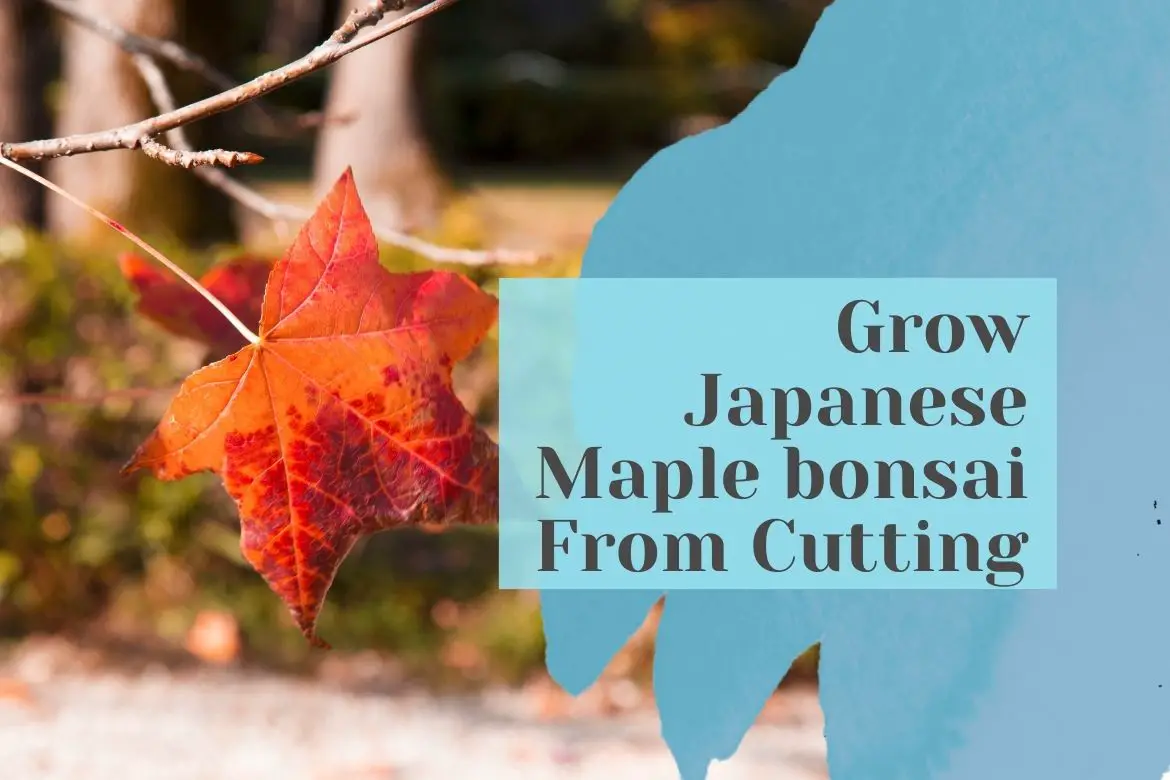It’s important to note that growing a Japanese Maple bonsai from a cutting can be a more challenging process than growing bonsai Japanese maple from seeds, as the success rate can be lower. However, this should not stop you from trying. Try and propagate more cuttings and practice the proper care to increase success rates.
Collecting the cuttings
Spring and early summer is a good time to collect Japanese maple cuttings. Collect semi-hardwood cuttings. Shoots that are 1 year old or less are perfect. These shoots will be soft.
Do not take hardwood cutting that are 3-5 year old. These won’t root when planted as cuttings. However, these are perfect branches for air layering.
In general, lower branches are weaker than upper branches. Hence, take cuttings from the upper branches (upper part of the canopy if possible) as these are more stronger and healthier. The chances of them rooting are higher.
Take 2-4 inch (5-10 cm) long cuttings. Cut the bottom of the cuttings at an angle (almost 45 degrees). Remove the lower leaves from the cutting to reduce water loss due to evaporation. However, keep a few leaves (2-3) on the cutting so that it can produce enough energy to root.
Preferably cut the shoot right below a node. This is the location which is most likely to produce roots.
As mentioned earlier, take multiple cuttings instead of just one. Most cuttings will not root. If you plant multiple cuttings, you have a better chance of obtaining a few plants with established roots.
Maples are sometimes infected with aphids. Hence it is very important to check the shoot before taking a cutting. Infected cuttings will not root. Select healthy shoots for cuttings.
As a precaution, you can prepare a solution of water, a little bit of soap and rubbing alcohol. Wash the cuttings in this solution to ensure that there are no aphids on the cuttings.
After collecting the cuttings, keep them in a jar of water for a few hours (you can even keep them in the jar for 1-2 days). You can also mix some rooting booster/ Plant vitalizer in the water. A lot of Japanese bonsai growers use Menedael (1:100), however you can use any brand available. That being said, it is not necessary.
Planting the cuttings
Select a small container deep enough for the cuttings to root. Fill the pot with soil. Japanese maple prefers sandy, acidic soil. There are many soil mixes you can use. For example, you can use a mix of loam, peat moss /coco husk, sand in the the ratio of 3:3:4.
Now you can pre-water the pot before planting the cuttings or you can water the pot after the cuttings have been planted. Any of the 2 approaches can work. If you decide to pre-water the pot, make sure that the the soil is completely moist.
Take the cuttings out of the jar of water, apply some rooting hormone and plant them in the soil.
It is crucial to plant cuttings deep enough so that they do not wiggle. This is very important because if the cuttings are not firmly planted in the soil, then they wont root. Keep the soil around the cutting firm by gently pressing it around the cutting.
You can also cover the pot with a plastic bag. The effect is similar to that of a mini greenhouse, and it also prevents any spread of disease to nearby plants.
Place the pot in a warm place in shade. You can expose it to the morning or late evening sun. However, keeping the pot in the shade all day long will also work. Also, keep the pot sheltered from the wind. Every time you notice the soil getting dry, gently water the pot.
Now, do not disturb the cuttings for at least 8 weeks. Do not pull on the cuttings to check rooting.
One of the signs that the cutting has started rooting is new growth. In about 8 weeks you should see good results if the cuttings has rooted. Most likely, cuttings that have not rooted will not show any signs of growth.
Transplanting the cuttings
Use chopsticks to gently move the soil around the plant. This will prevent the soft roots from getting damaged.
Remove the soil from one side so that you can easily grab the cuttings with roots and little bit of soil. Do not pull on the cutting while extracting it.
However, I would recommend, that you should not rush to transplant these cuttings into a new pot. For enough roots to develop, it may take several months (atleast 6 months). Repot these cuttings in early spring.
At the time of repotting the cutting in its individual pot, if the cutting is small and thin and the roots of the cuttings are not established enough, then wrap a 1-1.5 mm aluminum wire around the trunk of the cutting to provide support.
The wire will act as an anchor and help the flexible plant stand upright. This wiring will also help you in shaping the trunk of the tree at a very early stage. Continue reading about wiring a bonsai tree.
In about 2-3 years these plants should be ready to be trained as a Japanese maple bonsai. Continue reading about Japanese maple bonsai care guide.

